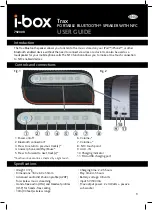
1)
SD Card Slot:
Use it to insert an SD card with MP3 files for playback.
2)
USB Disk:
Use it to insert a flash-based USB storage device (pendrive) with MP3 files for playback.
3)
Mode Selection and Playback Control:
Use the “Mode” switch to toggle between USB/SD and
Bluetooth modes. Use the play/pause, stop, repeat, previous/rewind and next/forward knobs to take
full control of your music playback.
Terms of Use:
Studiomaster Professional respects intellectual property rights and we request our
users to do the same. Please use MP3 downloads only from sources which you have legally
purchased. PLEASE DO NOT USE PIRATED MUSIC OR PROGRAMS.
Disclaimer:
Your acceptance and use of this product will be treated as your agreement to the
following clause: Studiomaster Professional, Audioplus and all associated companies and sellers are
indemnified from any liability the end-user may incur by using illegally procured material or immoral
content or any other such similar program selection.
4)
Status LEDs:
The Power LED indicates the ON and OFF status of the speaker. The Signal LED
indicates the presence of audio signals at any of the connected inputs. The Clip LED indicates clipping
or distortion at any of the connected inputs. Kindly reduce the input volume level on the speaker or
reduce the output level on the connected device/equipment.
5)
DSP Preset Controller:
The loudspeaker integrates the following DSP-based EQ sound presets - Flat,
Speech, Music, Live and Club. Use this rotary knob to toggle between the various DSP presets.
6)
DSP Preset LEDs:
These LEDs light up based on the respective DSP preset selected.
7)
Aux In:
This is a stereo RCA line input to connect devices such as CD/media players, iPods, MP3
players and DJ mixers etc.
8)
Line 2:
This combo XLR-Jack input accepts line-level signals from various sources.
9)
Line 2/Media Level Control:
Use this rotary knob to control the volume level of the line 2/Media
inputs (Clio 154) (see Pt. 7 & 8).
10)
Mic / Line 1:
This combo XLR-Jack input accepts both mic and line-level signals from various sources.
11)
Mic / Line 1 Input Sensitivity Selector:
Use this switch to change the input sensitivity between mic
and line. The mic mode is ideal to connect a dynamic microphone.
Note: Do not use a microphone in the line mode. Doing so may damage your equipment.
12)
Mic / Line 1 Level Control:
Use this rotary knob to control the volume level of the mic / line 1 input
(see Pt. 10).
13)
Line Out:
Use this balanced XLR (M) output to connect/link this speaker to an additional speaker.
14)
Power Switch:
Use this switch to power the speaker ON or OFF.
15)
Power Cord Input:
Use the supplied cord to power up the speaker. Kindly check and match the
voltage requirement indicated on the rating plate of the unit. Connect the power cord only to a mains
socket outlet with a protective earthing connection.
16)
Fuse Carrier:
Houses a fuse to protect the unit from unwanted power surges.
17)
Aux/Media Level Control:
Use this rotary knob to control the volume level of the Aux/Media input.
(Clio 84)
18)
Line 2:
This jack input accepts line level signal from various sources. (Clio 84)
19)
Line 2 Level Control:
Use this rotary knob to control the volume level of the line input. (Clio 84)
5
Bluetooth Operation and Indication
It displays ‘on’ and then “Well Come Please Wait ”
‘Bluetooth Unconnected’ on display.
Action
1) When Power On
2) Bluetooth mode
3) USB mode (Default mode)
4) SD/MMC mode
Indication for Clio 84
“Blue Display”
“Blue Display”
Indication for Clio 154
88:88
USB
88:88
SD
88:88
USB
88:88
SD
F
Plays any Mobile phone or other smart device with Bluetooth wirelessly.
F
Connect your smart device (Mobile phones, Laptops, Tablet phones etc.) & control music
directly from the palm of your hand.
F
13 meter range line of sight for Bluetooth connection gives you room to roam around your premises.
Clio Series Features


























